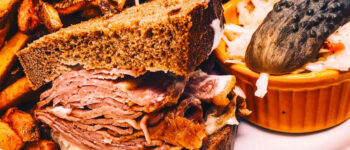QUESTION: When an ingredient list calls for “2 cups” of pasta, to what does that refer? Two cups of cooked pasta is enough, but being listed on the ingredient list causes me to think the recipe is calling for two cups of uncooked pasta. If so, how do you measure two cups of uncooked pasta? For instance, I wanted to use vermicelli as my pasta. What’s two cups of dry vermicelli? — Vince Romano, Grosse Pointe Park
ANSWER: When a recipe lists 2 cups of pasta, mostly likely it means dry pasta.
With Free Press Test Kitchen recipes, if we want you to use cooked pasta we would list it as “2 cups cooked pasta.” If we want you to use dry pasta, usually we’d list it as 2 cups (or 8 ounces or 1 pound, whichever amount is needed) pasta. We also would provide instructions for cooking the pasta or say “cooked according to package directions.” Also, if instructions for fully cooking the pasta are listed, it means dry pasta is used.
Measuring short pasta (bow-tie, rigatoni and elbow) is easy enough. But when it comes to spaghetti and vermicelli, half of a 1-pound box is about 2 cups. You can also do it by weight. Generally 8 ounces of short pasta (like macaroni) is about 2 cups.
Having said all that, what’s generally listed on the packages/boxes of most dry pasta as the serving size is 2 ounces. What does that look like? It will definitely depend on the size and shape. But generally, 2 ounces of dry pasta like penne or bow tie is about 1/2 cup. Once cooked, that amount yields 1 to 11/4 cups. Again, it depends on the size. When it comes to long strands of pasta, 2 ounces is typically 2 inches or just a smidgen more in circumference depending on the size of the noodle. That circumference yields about 1 cup of cooked pasta as listed at www.barilla.com. So a 1-pound box of dry pasta cooks up to about 8 cups.
Another question that comes up often when cooking pasta is whether the water should be salted or not. The answer is a resounding yes. How much salt to use? I always think of Mario Batali, who says you should add enough salt so the water tastes salty. At http://www.mariobatali.com, it’s recommended that for every 1 pound dry pasta you should use 6 quarts water and 3 tablespoons kosher salt, adding the salt to the water once it comes to a full boil.
Why salt the water? The advantage is simple: It seasons the pasta, adding flavor to the dish it’s used in. Also, it’s always recommended to reserve some of the pasta cooking water to add to, if using, a sauce. That reserved pasta water will all help season the sauce and because the water has starch from the pasta, it will also help thicken the sauce if need be.
Have a question? Contact Susan Selasky noon-3 p.m. Thursdays at 313-222-6872 or e-mail [email protected]. Follow her @SusanMariecooks on Twitter.
Penne with Broccoli, Sun-dried Tomatoes and Dijon Cream
Serves: 4 / Preparation time: 10 minutes / Total time: 30 minutes
See more : How Much Caffeine Is in Mountain Dew? (vs Coffee)
Cooking the broccoli for just 2 minutes keeps it vibrant green, and you don’t have to dirty another dish.
1 large clove garlic, peeled, minced
1/4 cup Dijon mustard
1 cup fat-free or regular half-and-half
8 ounces (about 2 cups) penne pasta or favorite short pasta
11/2 cups broccoli florets
1/3 cup sun-dried tomatoes, sliced
1 tablespoon olive oil
1/4 cup shredded or shaved Parmesan cheese
See more : 7 Best Gin Mixers for a Flavorful Twist
Freshly ground black pepper
2 tablespoons chopped fresh parsley, optional
Bring a large pot of salted water to a boil.
Meanwhile, place the garlic in a large, heatproof serving bowl that will fit partially in the pot. Add the mustard to the bowl and whisk in the half-and-half. Set aside or place over the pasta pot to warm while the water is heating. Once the water begins to boil, remove the bowl.
Add the pasta to the boiling water and cook until it is al dente, according to package directions. About 2 minutes before the pasta is done, add the broccoli florets and sun-dried tomatoes. Cook 2 more minutes. Remove 2 cups of the cooking water. Drain the pasta and broccoli and tomatoes. Place the cooking water back in the pot and leave on low heat.
Set the heatproof bowl with the mustard sauce over the pot with the remaining pasta water. Add the pasta mixture and toss to coat and heat through. Drizzle with the olive oil and add the cheese. Toss again to coat and heat through.
Garnish with a grinding of black pepper and a sprinkling of parsley before serving.
From and tested by Susan Selasky for the Free Press Test Kitchen.
320 calories (20% from fat), 7 grams fat (2 grams sat. fat), 51 grams carbohydrates, 12 grams protein, 437 mg sodium, 6 mg cholesterol, 2 grams fiber.
Nigel Gildon editor:Nigel Gildon is the editor of Chef Wayne’s Big Mamou: Chef Wayne’s Big Mamou. He has worked in the publishing industry for many years and has a passion for helping new authors get their work into the hands of readers. 63 Liberty Street * Springfield, MA 01003






